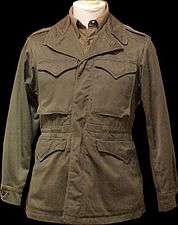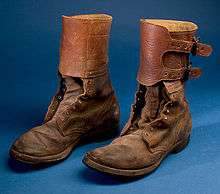U.S. Army M-1943 Uniform


The U.S. Army developed the M-1943 Uniform Ensemble manufactured in Herringbone Twill (HBT) beginning in 1942 to replace a variety of other specialist uniforms and some inadequate garments, like the OD Cotton Field Jacket.
Pre-1943
By 1941, soldiers wore a wool flannel shirt and wool serge trousers in winter and a cotton khaki shirt and trousers in summer, both with ankle length russet leather service shoes and OD canvas leggings, and often with the OD cotton M-1941 Field Jacket. A blue denim fatigue uniform was gradually being replaced by a M1941 green HBT uniform; both were in two pieces.
Armored units still were using wool riding breeches and wore high-lacing boots in some cases, and the Paratroopers were stuck with a general issue HBT overalls with no real suitable footwear.
As a result of this lack of proper and suitable clothing, the Armored units were issued general infantry uniforms, although by 1942 the winter coveralls and winter "tanker" jacket had been produced with them in mind. These articles of clothing were made of light green cotton lined with wool kersey.
The paratroopers got their own unique uniform in 1942, also. It was constructed of light green cotton twill, with four front pockets and two pant-leg cargo pockets. They also got a new boot design of their own, a leather boot of similar construction to the infantry shoe, only being mid-shin high.
Generally speaking though, this was unsatisfactory. The infantry uniform was lacking in functionality compared to the M-1942 Paratrooper uniform, and the tanker winter uniforms were sought after by almost every branch in the Army, making supply and production often difficult.
The combat wool, khaki, and paratrooper trousers all did not have adequate locking stitches in the crotch. Often trousers would tear at that stress point. Also, the paratrooper uniform would tear at the knees and elbows.
The paratroopers tried to fix the problem by sewing canvas patches on the elbows and knees, but the Army sought to standardize a better uniform.
Initial design
The most recognizable part of the uniform is the standardized field jacket. It was longer than the M-1941 jacket, coming down to the upper thighs. It was made in a light olive-drab OD7, later a darker OD9 cotton sateen. It also had a detachable hood, drawstring waist, two large breast pockets and two skirt pockets.[1]
The trousers were made out of the same cotton sateen material and regular cotton twill. They were made similarly to the khaki trousers, with better design features. They also had buttoned tabs at the waist in order to cinch the waist in.
The lightweight M1943 HBT shirt had two large chest pockets with the matching trousers having two large cargo pockets worn on the side. The latter was done as eliminating the previous side and back pockets saved costs and time in manufacture. This unit was designed to be layered either under the M1943 Winter uniform or alone as a warm-weather garment.
The uniform was designed to be warm in winter by use of a separate jacket liner and pant liner (this is why the trousers had buttoned waist tabs), both made of "pile" faux fur. The trouser pile liners were dropped in favor of ordinary wool trousers. The jacket liner was a separate cotton-shell jacket with two slash pockets and button and loop fastening, generally in a lighter shade of olive drab (OD3) than the main jacket but in practice rarely issued during World War II. In the ETO this was intended to be replaced by the M-1944 'Ike' jacket, or one of the generic 'ETO' jackets which could come in versions that were either near-identical to the M-1941 jacket, but in rough khaki wool outer, or versions almost identical to British Battledress, both versions being produced locally in the UK in several variations.
In all, a number of new items were designed or standardized in 1943 in order to improve the Army uniforms and individual equipment as much as possible:
- M-1943 field jacket and hood[1]
- Pile field jacket
- Field trousers
- Field trouser liner (dropped)
- Field cap
- Pile cap
- High-Neck Sweater
- M-1943 Combat Service Boots
- M-1943 goggles
- Field Pack (a redesigned Jungle Pack)
- M-1943 Entrenching Tool & Carrier
- Pocket, Cartridge, Cal .30, M1, Carbine or Rifle
- Rain poncho
- Wool sleeping bag & Case
- M3 gas mask (along with its M6 carrier)
- M1 Economy Helmet
Wartime use
The equipment was issued quickly around to units because it was usually well-made variants of current equipment. The uniform, though, took much longer to issue.
It was tested in Italy in 1943 but some GIs (including Bill Mauldin) claim that non-combatant officers and enlisted personnel would use their position in the rear to get the new uniform, delaying the ultimate field testing in Italy for some time longer. This, along with shipping delays after D-Day because of the European orders for the M-1944 "Ike" jacket, kept this uniform from widespread use in Europe until late 1944. After D-Day, Paratroopers were issued complete M-1943 uniforms, and infantry units began getting the uniform parts here and there.
Paratroopers were generally the only ones to modify the uniform, mainly because they would add their own trouser cargo pockets sometimes and would keep their older paratrooper boots instead of the new buckle boots.
The original cotton trousers were modified in 1944 (addition of trouser cuff tabs) and as M-1945 pattern with minor cut modifications and a move from stud to plastic buttons.
In practice the pile liner was very rarely issued outside initial trials in North Africa during World War II and is mostly seen in photographs worn as outerwear. However it saw use in Korea, although again sometimes as outerwear.
Postwar impact
The 1943 pattern uniform was superseded by the 1950 pattern from 1950 which simply changed to a button-in liner. The jacket of the 1951 pattern uniform owes much to the 1943 pattern but uses bi-swing pleats, the use of zip and stud fastening. The 1951 pattern trousers are of new design. The 1965 pattern closely follows the 1951 pattern. The latest version of the jacket, the M-65, is still in service, and differs from the M-1943 in that now it is made of a tougher cotton/nylon mix and comes in the new Army digital camouflage. It is no longer used for combat operations having been superseded by the Gen II and Gen III Gore-Tex parkas.[1] The liner is also filled with newer polyester fills.
The "Jeep cap" (Cap, Wool Knit, M-1941) remained in service until the 1950s. This cap was worn in the film and TV series M*A*S*H by fictional character Cpl. Walter "Radar" O'Reilly.
The combination poncho/tent section would serve in Korea later.
A new uniform, known as OG-107, was first introduced in 1952. By the beginning of the Vietnam War, it had completely replaced the M-1943 Uniform as the standard in the Army.